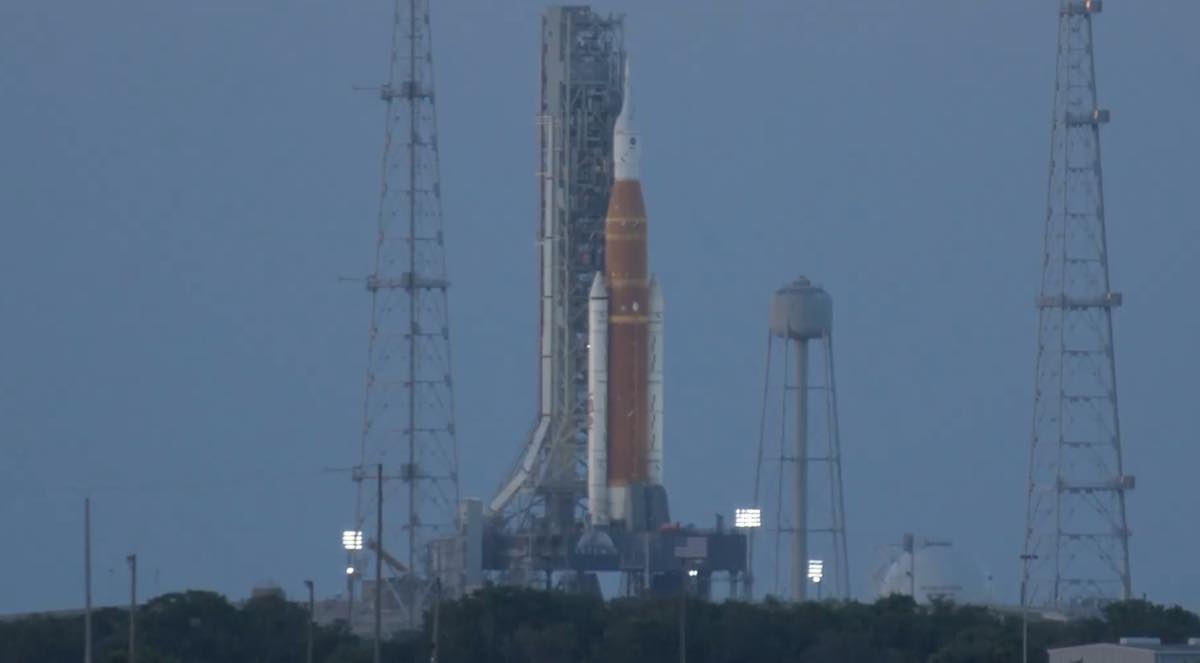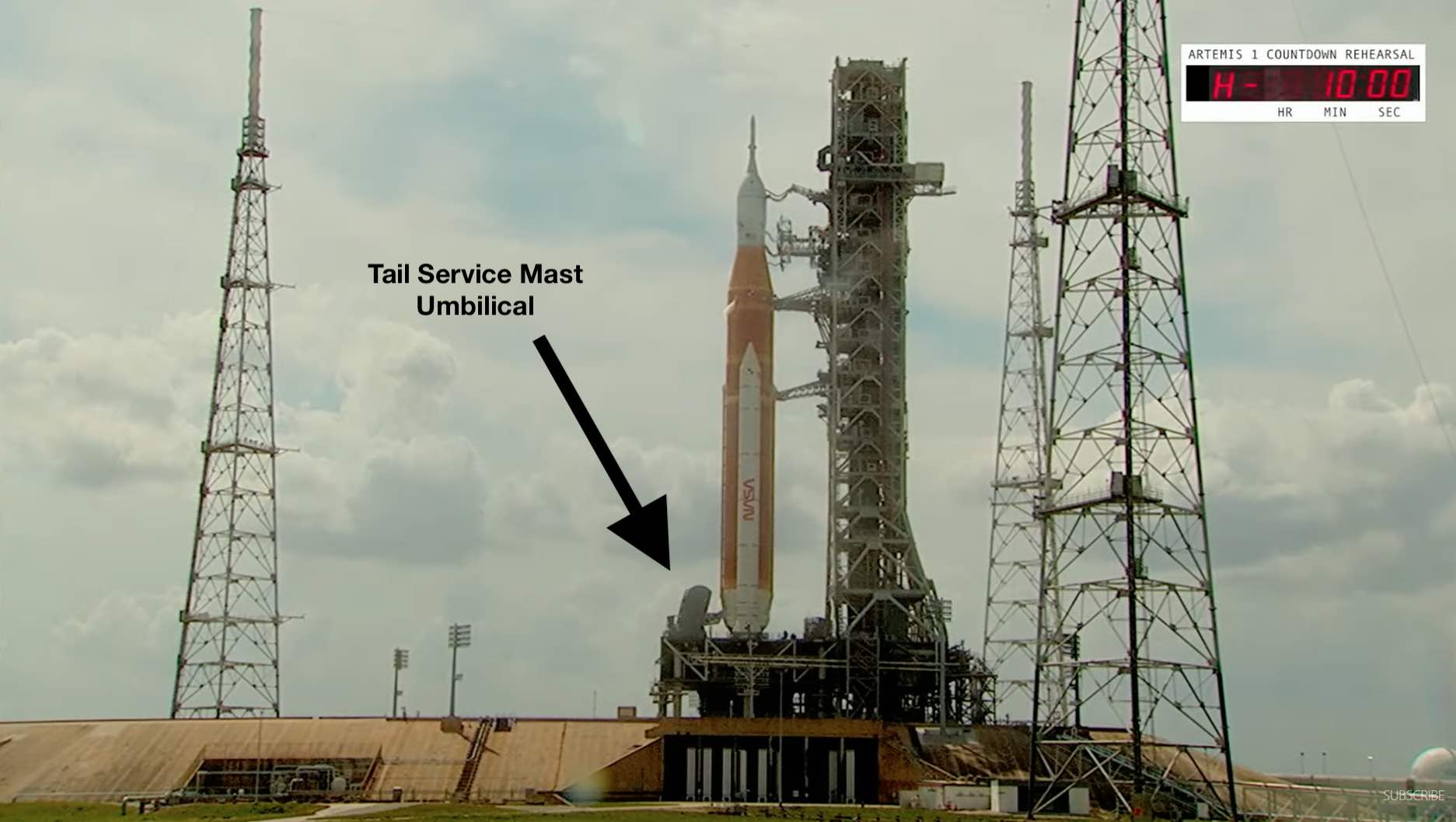Space News & Blog Articles
NASA to return Artemis moon rocket to assembly building for repairs
 NASA’s Space Launch System moon rocket on pad 39B on Saturday evening. Credit: Spaceflight Now
NASA’s Space Launch System moon rocket on pad 39B on Saturday evening. Credit: Spaceflight Now
NASA will move the Space Launch System moon rocket back into the Vehicle Assembly Building at the Kennedy Space Center to replace a failed valve and fix a hydrogen leak found during tests at the launch pad, the agency announced late Saturday.
It wasn’t known Saturday when the rollback might occur, or how long the unplanned return to the VAB might delay the eventual launch of the towering moon rocket on NASA’s Artemis 1 test flight. The mission was previously planned for launch some time in June, but the rollback will likely push back the oft-delayed test flight later in the summer.
NASA officials will brief reporters at 3 p.m. EDT (1900 GMT) Monday to discuss their plans for rolling the SLS moon rocket back to the assembly building. The 322-foot-tall (98-meter) rocket moved to Launch Complex 39B last month in preparation for a countdown rehearsal.
The rocket will launch an unpiloted Orion crew capsule around the moon on a test flight before NASA puts astronauts on the second SLS/Orion mission. The Artemis program aims to return astronauts to the moon later this decade.
The practice countdown at pad 39B is intended to find problems and ensure the SLS moon rocket and ground systems are ready for launch day.
NASA’s launch team was unable to fully load the Space Launch System moon rocket with super-cold liquid hydrogen and liquid oxygen during three attempts this month. An issue with ventilation fans prevented teams from loading the rocket with propellant April 3, and a misconfigured valve at the launch pad cut short another tanking test April 4.
NASA also found a failed helium check valve on the rocket’s upper stage. Managers decided to forego loading of propellants into the upper stage during the third countdown rehearsal Thursday.
The launch team ran into an issue with a gaseous nitrogen supply from Air Liquide, a contractor that operates an off-site plant and routes gases into the space center through a pipeline. The gaseous nitrogen is used to purge parts of the rocket to reduce the risk of fire during propellant loading.
The gaseous nitrogen flow was restored, and NASA started loading propellants into the core stage Thursday afternoon. The core stage liquid oxygen tank was filled to about 49% full, but the liquid hydrogen flow was stopped at the 5% point after engineers detected a hydrogen leak.
The leak was located in the tail service mast umbilical, the connection where cryogenic propellants flow from the rocket’s mobile launch platform into the core stage.
Air Liquide’s nitrogen supply also had trouble during the April 4 countdown rehearsal, delaying the start of propellant loading on that day by several hours.
“Due to upgrades required at an off-site supplier of gaseous nitrogen used for the test, NASA will take advantage of the opportunity to roll SLS and Orion back to the Vehicle Assembly Building to replace a faulty upper stage check valve and a small leak on the tail service mast umbilical,” NASA said in a statement. “During that time, the agency also will review schedules and options to demonstrate propellant loading operations ahead of launch.”
 The tail service mast umbilical is located n the SLS Mobile Launcher deck, connecting to the base of the rocket’s core stage. Credit: NASA / Spaceflight Now
The tail service mast umbilical is located n the SLS Mobile Launcher deck, connecting to the base of the rocket’s core stage. Credit: NASA / Spaceflight Now
“Hydrogen is extremely hazardous, cold, and a small molecule that is known for leaking,” tweeted Jeremy Parsons, deputy manager of NASA’s exploration ground systems program at Kennedy, during Thursday’s countdown rehearsal. “All of these systems have been sealed, leak checked and tested to the highest extent possible prior to wet dress rehearsal.”
But the leak checks between the SLS core stage and the mobile launch platform have, until recent fueling tests, all occurred at warm ambient temperatures. Liquid hydrogen fuel is chilled to minus 423 degrees Fahrenheit (minus 253 degrees Celsius), and liquid oxygen is stored at minus 297 degrees Fahrenheit (minus 183 degrees Celsius).
At those temperatures, valves, seals, and gaskets can contract and change shape, revealing a leak that wasn’t apparent in warmer conditions. Hydrogen can find its way through seals that would contain other molecules.
“Under the unique operating conditions with the rocket, we are prepared and know leaks are a realistic possibility,” Parsons tweeted Thursday. “We have amazing hazardous gas and leak detection systems that keep the rocket safe and alert us to conditions outside of normal parameters.”
NASA said the leak discovered Thursday is located in an area called the “purge can” on the exterior of the tail service mast umbilical. The purge can is attached to the umbilical plate, which would retract into the structure’s protective housing at liftoff.
Hydrogen leaks have cropped up in other rocket programs. NASA engineers spent months tracing hydrogen leaks that kept NASA’s space shuttles grounded in 1990.
“Having lived through ‘the summer of hydrogen leaks’ on the shuttle I can sympathize,” tweeted Wayne Hale, a former NASA flight director and former manager of the space shuttle program. “And that was after 35 or so launches. A leak the first time is almost to be expected. But not satisfactory.”
This email address is being protected from spambots. You need JavaScript enabled to view it. the author.
Follow Stephen Clark on Twitter: @StephenClark1.
When you subscribe to the SpaceZE News Feed, we will send you an e-mail when there are new updates on the site so you wouldn't miss them.

